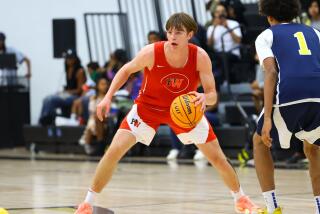Soccer players face split decision
Chris Cummings is one of the nation’s top high school soccer players, a quick and aggressive forward-midfielder described by his coach as “electric” and “charismatic.”
He was looking forward to playing his senior season with his best friends at Encino Crespi High before moving on to UCLA in the fall on a soccer scholarship.
Instead, he attends Crespi games in street clothes, “dying to get out there,” Coach Rob Kodama said, but barred from playing by a collision of interests that is causing angst in youth sports circles.
Cummings isn’t alone in his frustration. One by one, dozens of the top players in Southern California have disappeared from their high school teams so they can play for private clubs in a program created last year by the U.S. Soccer Federation to groom promising young talent for international competition.
With boys’ high school soccer played during the fall in most of the nation, the development program was slated to run from November through early summer, generally avoiding conflict. But in weather-friendly, soccer-mad Southern California, the high school season is contested in winter, posing a dilemma for dozens of top players.
The local clubs in the program, as well as the California Interscholastic Federation, the governing body for high school sports in the state, say the athletes can’t play for their clubs and schools at the same time. So most of the players faced with a choice have opted to join the development program, with its top-tier coaching and competition stoking dreams of college, professional and international play.
In the last 20 years or so, club sports have become big business, with private coaches being paid thousands of dollars to develop elite athletes -- and the parents of those athletes paying up to $7,000 a year to participate.
Club programs in most sports have generally tried to steer clear of the high school seasons, though some clashes have occurred. National high school sports officials say the soccer program marks the most extensive collision to date, and worry that other club programs might feel empowered to follow suit -- trampling tradition and siphoning off top talent, male and female, in a host of sports.
For many high school coaches, the soccer situation has been a headache, or worse.
“This is open-heart surgery,” said Martin Stringer, coach at Santa Ana Mater Dei, which lost four starters to the development program. “We’re hemorrhaging. It’s the first blatant time kids have had to make a choice.”
The overlap issue was a major topic of discussion at this month’s winter meetings of the National Federation of State High School Assns., said assistant director Mark Koski.
With more than 7 million students participating in high school sports, Koski said his organization’s main objective is to produce “lifelong positive citizens” and not necessarily Olympic champions. But the proliferation of club programs nationwide shows there’s a growing pursuit of athletic excellence.
“It’s definitely a concern to us because it means fewer participants at the high school level,” Koski said. “The concern is how many other sports are going to come along.”
John Hackworth, director of the development program, said U.S. Soccer encourages participants also to play for their high school teams. He said the six elite club programs in the Southland -- Irvine Strikers, Pateadores, Real SoCal, L.A. Football Club, Arsenal and Chivas -- decided on their own to require their players to pick between the club and high school teams.
“We are not telling them they have to make that choice,” Hackworth said.
At a meeting last week, commissioners from the 10 CIF sections discussed whether to alter the state rule that bans most athletes from competing simultaneously with their school and club teams, but took no action.
“I don’t see us revising it in the near future,” said CIF executive director Marie Ishida.
Loosening the rules could provoke outcries that athletes would be spending too much time playing and practicing, affecting their studies.
In Europe and South America, meanwhile, professional teams recruit, develop and pay for the young talent that will play for their national teams. In the United States, where the storied women’s soccer team has won World Cup and Olympic championships and inspired a generation of girls, pressure was building to create comparable success for the men, leading to formation of the program.
“This is the first step in a long marathon to take care of youth soccer,” said Marwan Ass’ad, director of coaching for Calabasas’ Real SoCal. “In other countries, when you’re 18 years old, you can be sold for $5 million. How do you produce those players? You can’t produce world-class players in high school soccer.”
Cummings is Real SoCal’s top player. As a sophomore, he helped Crespi win its first league title in 20 years. Last January, he left for a six-month stint at U.S. Soccer’s full-time residency program at the IMG Academy in Bradenton, Fla., training with 40 players vying for spots on the U.S. team composed of top players younger than 17.
“It was a good experience, one you couldn’t pass up,” he said.
Cummings trained in the morning and went to school in the afternoon, with all expenses paid by U.S. Soccer. He kept track of Crespi’s season by calling his classmates on the phone.
Back at Crespi for his senior year, he played in one game in December but is no longer on the team because Real SoCal won’t allow it.
“It was pretty hard,” Cummings said of his decision not to play for Crespi this season. “I couldn’t go back to my club team if I quit.”
Said Ass’ad: “Chris Cummings is one of our brightest stars. Who knows how far he can go? Our hopes rely on his development. In this plan, he will play in 22 competitive games in the next six months.”
Some high school coaches say it would be wrong to advise a player to turn down the development program.
“We’re powerless,” said Mark Sobel, coach at the Sherman Oaks Center for Enriched Studies. “There’s nothing we can do. They say, ‘It’s your choice,’ but if I had the opportunity to travel to Florida or Europe, what would you do?”
Still, they rail at what they say is a harmful incursion.
“It’s part of the American teenage culture, and they’re taking it away,” Mater Dei’s Stringer said. “You’re penalizing kids for being good soccer players.”
Added Crespi’s Kodama: “In the big picture, high school sports is extremely special because of the memories. In club, there’s no school to come back to, no hall to walk back through. The kids are going to be the ones who lose out.”
But not every elite player has ditched his high school mates for the dream of international play.
Senior goalie Grant Windes and junior midfielder Austin McAnena quit their club teams rather than give up playing for Santa Margarita.
“It was a hard choice,” Windes said. “For me, club is real serious. You really improve your skills. But in high school, you’re with your friends.”
--
More to Read
Get our high school sports newsletter
Prep Rally is devoted to the SoCal high school sports experience, bringing you scores, stories and a behind-the-scenes look at what makes prep sports so popular.
You may occasionally receive promotional content from the Los Angeles Times.







